 Morphology
Morphology 
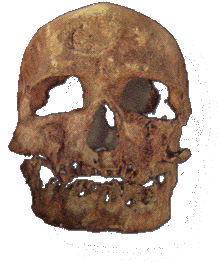
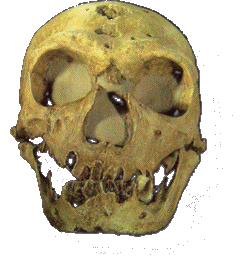
Casts from the American Museum of Natural History. On the left is
the old Cro-Magnon Man
and on the right is
the old man of La-Chapelle-aux-Saints. 
 Morphology
Morphology 


Casts from the American Museum of Natural History. On the left is
the old Cro-Magnon Man
and on the right is
the old man of La-Chapelle-aux-Saints. 
![]() As you can see in the photo above, Neandertal bone
structure and morphology was somewhat different from modern man's. Neandertals
were better adapted for harsh, cold climates. Their bodies were short and squat,
which primarily helped in keeping them warm in nasty, below freezing Ice Age
weather. It has been speculated that their noses and large nasal cavities were
also an adaptation to the cold climates that they lived in. With larger nasal
passages, cold air could be quickly warmed while breathing.
As you can see in the photo above, Neandertal bone
structure and morphology was somewhat different from modern man's. Neandertals
were better adapted for harsh, cold climates. Their bodies were short and squat,
which primarily helped in keeping them warm in nasty, below freezing Ice Age
weather. It has been speculated that their noses and large nasal cavities were
also an adaptation to the cold climates that they lived in. With larger nasal
passages, cold air could be quickly warmed while breathing.
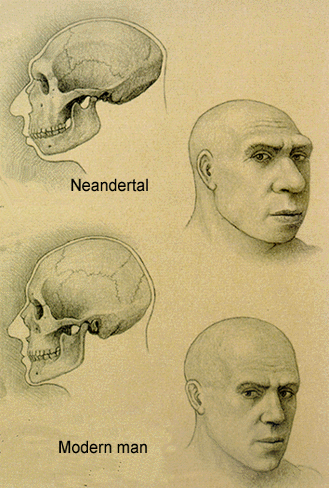 |
| This illustration, from Juan Luis
Arsurga, et al's Atapuerca, shows the difference
between Modern man's and Neandertal's craniums. Click on the image for a larger view. |
![]() Neandertals also
Neandertals also  had
different shaped skulls than our own. If you look carefully you can see that
they have low, sloping foreheads, whereas ours are much higher. In viewing this,
one can speculate that their brains were situated somewhat differently.
Neandertals' brains were longer and lower, and rested behind as well as above
the face (Tattersall 1995). Despite the fact that their brains were the same
size as ours, and sometimes larger, no one knows what the importance of the
difference in brain shape in Neandertals represented.
had
different shaped skulls than our own. If you look carefully you can see that
they have low, sloping foreheads, whereas ours are much higher. In viewing this,
one can speculate that their brains were situated somewhat differently.
Neandertals' brains were longer and lower, and rested behind as well as above
the face (Tattersall 1995). Despite the fact that their brains were the same
size as ours, and sometimes larger, no one knows what the importance of the
difference in brain shape in Neandertals represented.
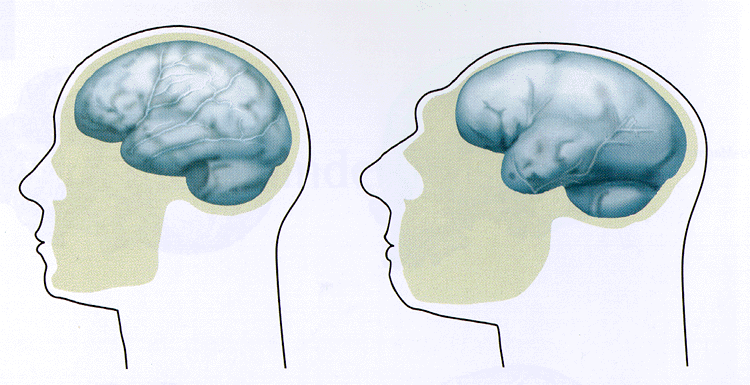 |
|
to modern man. Click on the image for a full-sized view. |
![]() Another interesting thing about these hominids'
morphology was that their bones were much larger and thicker than modern humans.
Their leg, foot, and hand bones were especially sturdy. According to Neandertal
specialist Erik Trinkaus, "these guys were built like Arnold Schwartznegger
naturally." I believe he said that in an episode of Archaeology. Taking this
into account though, imagine how built Arnie was during the Mr. Universe
competition. Now think about this body structure as being natural to a human
being. They do not have to work for it because they were born this way. Well,
that was what it was like for Neandertals. They could have won the Mr. Universe
competitions without even bothering to train for it
Another interesting thing about these hominids'
morphology was that their bones were much larger and thicker than modern humans.
Their leg, foot, and hand bones were especially sturdy. According to Neandertal
specialist Erik Trinkaus, "these guys were built like Arnold Schwartznegger
naturally." I believe he said that in an episode of Archaeology. Taking this
into account though, imagine how built Arnie was during the Mr. Universe
competition. Now think about this body structure as being natural to a human
being. They do not have to work for it because they were born this way. Well,
that was what it was like for Neandertals. They could have won the Mr. Universe
competitions without even bothering to train for it
 |
 |
![]() Some paleoanthropologists have theories about why
these hominids had the kind of morphology they did. One idea is that since
Neandertals led strenuous lives, they would definitely need a strong bone
structure. "Bone is responsive to the stresses placed on it in life, and it has
long been suggested that the heavy build of Neandertal is a result of a
particularly strenuous lifestyle," according to Ian Tattersall (Tattersall
1995:175). Keep in mind they were hunting very close and getting constantly
injured in their struggle to survive. Also, these hominids did much foraging
across various terrain, not really planning where and when they
going.
Some paleoanthropologists have theories about why
these hominids had the kind of morphology they did. One idea is that since
Neandertals led strenuous lives, they would definitely need a strong bone
structure. "Bone is responsive to the stresses placed on it in life, and it has
long been suggested that the heavy build of Neandertal is a result of a
particularly strenuous lifestyle," according to Ian Tattersall (Tattersall
1995:175). Keep in mind they were hunting very close and getting constantly
injured in their struggle to survive. Also, these hominids did much foraging
across various terrain, not really planning where and when they
going.
![]() Others have suggested, that in terms of the
projecting midfacial features of Neandertals, that they were an anchor for their
heavy jaw muscles, which as has been previously mentioned, were used a means of
gripping objects. These others have also suggested that Neandertals faces were
the way they were because of a part of a mating recognition system that existed
between them. This basically means that these hominids recognized each other by
their distinctive facial features. This paradigm has also been used to claim
that Neandertals did not interbreed with Homo sapiens.
Others have suggested, that in terms of the
projecting midfacial features of Neandertals, that they were an anchor for their
heavy jaw muscles, which as has been previously mentioned, were used a means of
gripping objects. These others have also suggested that Neandertals faces were
the way they were because of a part of a mating recognition system that existed
between them. This basically means that these hominids recognized each other by
their distinctive facial features. This paradigm has also been used to claim
that Neandertals did not interbreed with Homo sapiens.
![]() Of course, don't get me wrong
but, you also must know that there are two different varieties of Neandertals,
'classical' and 'progressive'. The morphology which we have been
discussing is primarily that of 'classic' Neandertals, much like the ones in the
photos above. 'Progressive' Neandertals, on the other hand, do not have as many
strong features as the 'classic's' we have been talking about. They had less
pronounced browridges, less midfacial projection, and they were more tall and
gracile than the 'classic's. Their bone structure was also not as robust as
their counterparts. In fact, some believe that 'progressive' could possibly
represent hybrids of Neandertals and Homo sapiens.
Of course, don't get me wrong
but, you also must know that there are two different varieties of Neandertals,
'classical' and 'progressive'. The morphology which we have been
discussing is primarily that of 'classic' Neandertals, much like the ones in the
photos above. 'Progressive' Neandertals, on the other hand, do not have as many
strong features as the 'classic's' we have been talking about. They had less
pronounced browridges, less midfacial projection, and they were more tall and
gracile than the 'classic's. Their bone structure was also not as robust as
their counterparts. In fact, some believe that 'progressive' could possibly
represent hybrids of Neandertals and Homo sapiens.
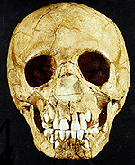 |
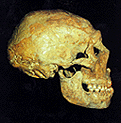 |
 |
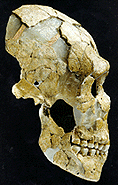 |
![]() As you can see, Neandertals still pose questions
for us that only they can answer. Hopefully, one day we will crack the code and
the secrets of Neandertal Man will be revealed. Until then all we have left to
rely on is the fossil record. One in which these ancestors still grin at us
quietly, as if almost mocking us, for it is they who know the answers to our
puzzling questions. Maybe in the end it will be the Neandertal that has the last
laugh.
As you can see, Neandertals still pose questions
for us that only they can answer. Hopefully, one day we will crack the code and
the secrets of Neandertal Man will be revealed. Until then all we have left to
rely on is the fossil record. One in which these ancestors still grin at us
quietly, as if almost mocking us, for it is they who know the answers to our
puzzling questions. Maybe in the end it will be the Neandertal that has the last
laugh.
![]() You probably have one last question you would like
to ask. What did Neandertals look like? Well in the picture below you can see.
The one on the left is from a project headed by Erik Trikaus at the University
of New Mexico. The computer animated reconstruction on the right is from
National Geographic Magazine.
You probably have one last question you would like
to ask. What did Neandertals look like? Well in the picture below you can see.
The one on the left is from a project headed by Erik Trikaus at the University
of New Mexico. The computer animated reconstruction on the right is from
National Geographic Magazine.
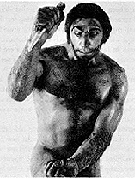 |
 |
![]() Do you see a resemblance?
Do you see a resemblance?
![]()